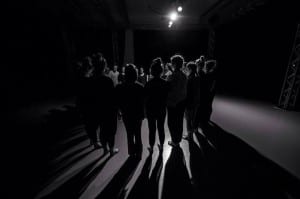Our final session consisted of a recap of the basics of contact – such as body surfing and table top. Then proceeded into a jam to practice Stark-Smith’s Underscore. The underscore is
“a score that guides dancers through a series of ‘changing states’, from solo deepening/releasing and sensitising to gravity and support; through group circulation and interaction.” (Koteen & Stark-Smith, 2008, 90).
This ranges from collision, confluence, skinesphere – and many other forms of connections I experimented with. This particular session I felt so deep into the jam and internalized in my body. The professional lighting rig and photographers made me work harder and bring my energy into the space, as a soloist and duets/small groups. I worked with new partners this session also which was successful to me – as I have been wanting this for weeks. I believe that this session was an achievement for myself and my peers and I am proud of how I have developed these skills which I hope to maintain for the rest of my dance career.
This semester, contact improvisation has brought me fresh and familiar knowledge for my body to experience. To begin, I was nervous and shy to make contact with people in the space, and lack sense of gravity, release and momentum. By the end of the semester I was not afraid to approach people and use the skills I have been taught – which can also be applied to technique. I have the confidence to have mutual connections as the over/under dancer and am willing to try new experiences in my body. The trust for my peers has also grown, making my time spent with them valuable and safe practice.

References
Koteen, D. & Smith, N. S. (2008). Caught Falling: The confluence of contact improvisation, Nancy Stark Smith, and other moving ideas. Northampton, Massachusetts: Contact Editions